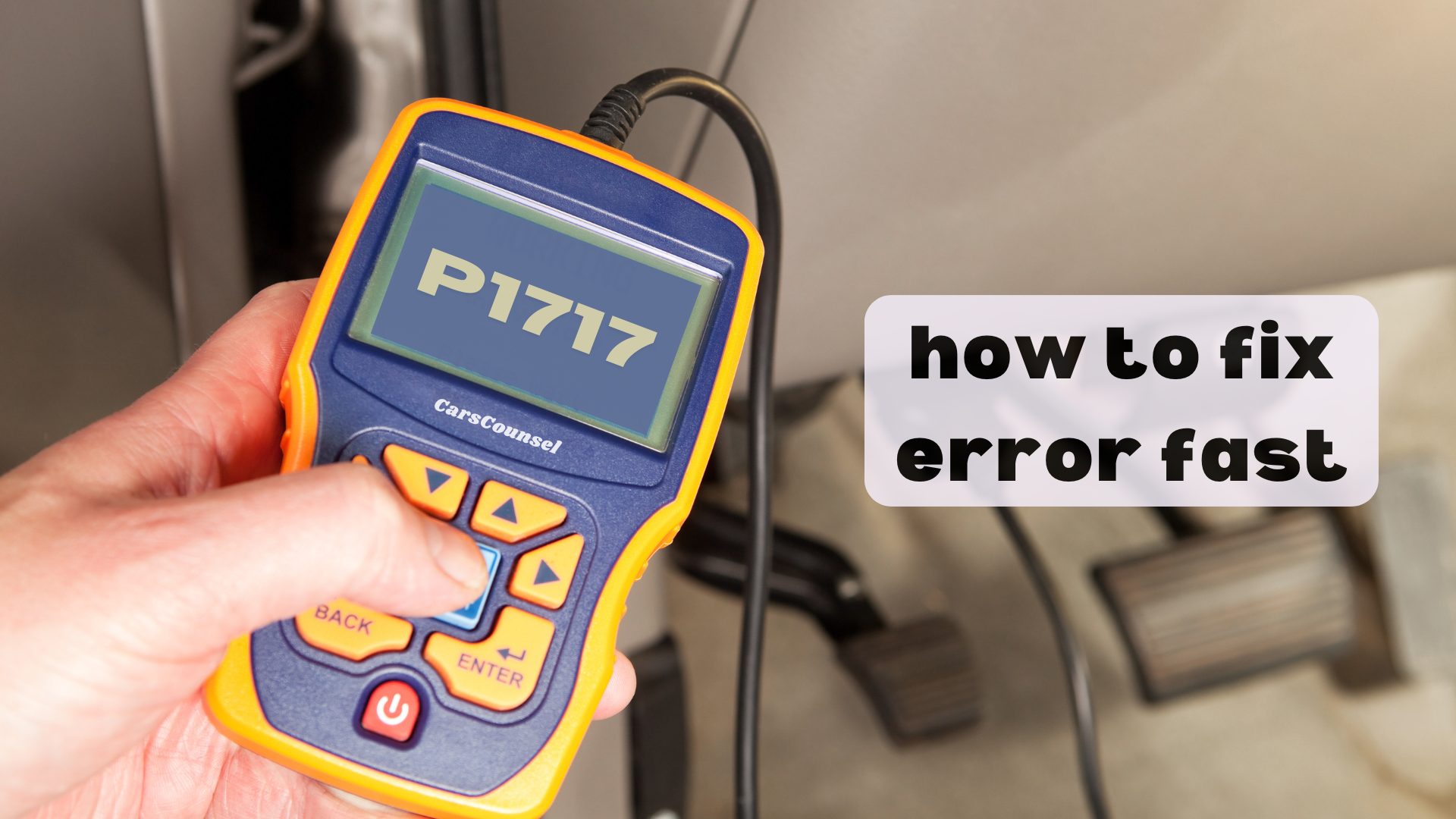Did you know that nearly 30% of car owners deal with transmission problems within the first five years?
If your car has a P1717 code, don’t worry; you can usually fix it without too much hassle.
By using an OBD-II scanner and checking key parts like the Input Shaft Speed Sensor and transmission fluid, you can often find the issue quickly.
Want to make sure your car runs smoothly again? Knowing the common causes and easy fixes for this error codes can really help.

Quick Navigation
Key Takeaways
- Use an OBD-II scanner to read the P1717 code and related problems.
- Look at the Input Shaft Speed Sensor (ISS) and the transmission fluid temperature sensor. Replace them if they’re faulty.
- Check the sensor wiring for any damage or rust and fix it if needed.
- Make sure the transmission fluid is clean and at the right level.
Understanding the P1717 Code
The P1717 code means there’s a problem with your car’s Input Shaft Speed Sensor (ISS) or the transmission fluid temperature sensor.
The ISS tracks how fast the transmission’s input shaft is spinning, which helps with smooth gear changes. If the temperature sensor isn’t working, the car’s computer can’t properly control the transmission fluid temperature. These sensors are crucial for how well your car runs.
If the input shaft sensor fails, your car might shift gears poorly and use more fuel. If the temperature sensor has issues, it can cause jerky shifting and could even lead to the transmission overheating.
You’ll need an OBD-II scanner to figure out exactly which sensor is causing the problem and to fix it before it causes more damage.
Common Symptoms
When your car shows a P1717 code, you might notice problems like rough shifting, lower gas mileage, and unexpected gear changes. These issues suggest that your transmission isn’t working well, mainly because some sensors aren’t functioning properly.
You could experience delays when shifting gears, random gear changes, or even gears slipping. Additionally, you might see a noticeable drop in fuel efficiency.
These problems happen because the transmission can’t correctly use data from the Input Shaft Speed Sensor (ISS) or the transmission fluid temperature sensor. Constant sensor errors make it hard for the powertrain control module (PCM) to manage the transmission effectively.
Fixing these issues quickly can help avoid further damage and ensure smoother, more efficient driving.
Causes of P1717 Code
Understanding why the P1717 code appears can help you figure out the exact problem and fix it properly.
Common causes include faulty sensors, like the Input Shaft Speed Sensor or the transmission fluid temperature sensor. These sensors can have issues due to wear, damage, or dirt.
Wiring problems, such as damaged or corroded wires, are also a big factor. Make sure to check all the wiring to ensure everything is connected properly and free from rust or corrosion.
Additionally, low or dirty transmission fluid can mess with sensor accuracy. Internal transmission problems and environmental factors, like extreme temperatures and moisture, can make sensor issues worse.
Knowing these causes will help you fix the P1717 code quickly and correctly.
Affected Car Models
[Affected Car Models]
Some car models are more likely to get the P1717 code, so it’s important to keep an eye on these vehicles. The Ford Focus and Nissan Altima are especially prone to this issue because of problems with their transmission sensors. For instance, the Ford Focus often has automatic transmission troubles related to speed sensor faults. Similarly, the Nissan Altima is known to jerk or hesitate when shifting gears due to sensor issues. Knowing which models are affected can help you take preventive steps and fix problems quickly.
| Car Model | Common Issue | Symptoms |
|---|---|---|
| Ford Focus | Speed Sensor Faults | Poor shifting, erratic behavior |
| Nissan Altima | Sensor Malfunctions | Jerking, hesitation during shifts |
| Chevy Malibu | Transmission-Related Recalls | Transmission failure |
Diagnostic Tools Needed
To accurately diagnose the P1717 code in affected car models, you’ll need specific tools to find out what’s wrong.
Diagnostic scanners and sensor testing equipment are essential for this process. Here are the tools you’ll need:
- OBD-II Diagnostic Scanner: This tool reads the P1717 code and other related codes from the vehicle’s computer system.
- Multimeter: Use this to test sensors by measuring the resistance and continuity of the Input Shaft Speed Sensor (ISS) and transmission fluid temperature sensor.
Having these tools ensures you can accurately identify and fix the root cause of the P1717 code.
Step-by-Step Diagnosis
First, connect an OBD-II diagnostic scanner to your vehicle’s diagnostic port to get the P1717 code and any other related codes.
Then, check the Input Shaft Speed Sensor (ISS) and the transmission fluid temperature sensor to make sure they’re working correctly.
Use the scanner to calibrate the sensors to ensure you get accurate readings.
Observe the transmission’s performance by monitoring the shifts and noting any issues.
Look at the sensor wiring for any damage or corrosion, as bad connections can mess up the sensor signals.
Use a multimeter to compare the sensors’ resistance to what the manufacturer specifies.
Lastly, refer to your vehicle’s service manual to ensure you follow the correct diagnostic procedures.
This method ensures a complete and precise diagnosis of the P1717 code.
Checking Fluid Levels
After retrieving the P1717 code with the OBD-II scanner and checking the sensors, the next step is to check the transmission fluid levels to make sure they’re within the recommended range.
Start by inspecting the fluid to ensure it’s properly maintained. Poor fluid conditions can cause inaccurate sensor readings and worsen transmission problems.
- Find the Dipstick: Locate the transmission fluid dipstick, usually marked and found near the engine bay.
- Check the Fluid Level: Pull out the dipstick, wipe it clean, reinsert it, and then check the fluid level.
Keeping the fluid in good condition ensures accurate sensor readings and a healthy transmission.
Inspecting Sensors
Checking the Input Shaft Speed Sensor (ISS) and the transmission fluid temperature sensor is crucial for figuring out the P1717 code.
Start by using a multimeter to measure the resistance of the ISS and compare these readings to what the manufacturer recommends to make sure the sensor is working correctly.
Next, test the transmission fluid temperature sensor to see if the circuit is complete. If there’s a break, it might be faulty.
Look at the wiring and connectors for any damage or rust, which can affect how well the sensors work.
Accurate readings from these sensors are important, so fix any issues you find right away.
Repair and Replacement Options
To fix the P1717 code, start by checking and repairing any damaged or corroded wiring connected to the Input Shaft Speed Sensor (ISS) and the transmission fluid temperature sensor.
Make sure all the wiring connections are solid.
Next, replace any faulty sensors to ensure accurate readings. After installing the new sensors, calibrate them so the transmission control module can read the data correctly.
- Wiring Check: Look for any signs of damage, rust, or loose connections.
- Sensor Replacement: Swap out the ISS or temperature sensor if they aren’t working right.
Follow these steps to clear the P1717 code and get your vehicle running smoothly again.
Preventive Measures
Regularly checking your transmission fluid levels and looking over the wiring and connectors can help you avoid the P1717 code.
Preventive maintenance should include routine inspections to make sure your transmission fluid is clean and at the right level. Dirty or low fluid can cause sensor problems.
Also, take the time to check the wiring and connectors for the Input Shaft Speed Sensor (ISS) and the transmission fluid temperature sensor for any signs of damage or rust.
Make sure the sensors are calibrated correctly during maintenance for accurate readings.
More OBD-II Codes
Frequently Asked Questions
Can Driving With a P1717 Code Cause Long-Term Damage?
Driving with a P1717 code can harm your transmission over time. Ignoring it might cause problems with shifting gears, lower gas mileage, and even damage the engine or transmission, leading to expensive repairs.
How Much Does It Typically Cost to Fix a P1717 Code?
The cost to fix a P1717 code can vary a lot. Usually, a diagnostic check costs between $50 and $100. If you need to replace sensors or wiring, it can cost between $150 and $400. More complicated transmission repairs can cost much more. It’s a good idea to get an estimate first so you don’t get surprised by the bill.
Are There Any Temporary Fixes for the P1717 Code?
For a quick fix, you can check and add transmission fluid if it’s low. Also, look at the sensor connectors and clean them to ensure they are making good contact. These simple steps might help for now, but you should get to the root of the problem to avoid more damage later on.
Can a P1717 Code Affect My Vehicle’s Warranty?
When it rains, it pours. A P1717 code can affect your car’s warranty. Whether the repair is covered may depend on if the issue is due to a factory defect or poor maintenance. Always check your warranty details.
Is It Safe to Drive With a P1717 Code for Short Distances?
Driving with a P1717 code, even for short trips, might not be safe. This code means there could be problems with the transmission, which can get worse and cause erratic shifting or damage to the transmission. It’s best to fix the issue as soon as possible.
Conclusion
You’ve tackled the P1717 code like a champ! With your OBD-II scanner, you found the issue, checked the sensors, and made sure the fluid levels are just right.
By fixing the faulty parts and taking care of your transmission, you’ve not only got your car running smoothly again but also stopped future problems.
Regular maintenance isn’t just a good idea—it’s essential for your car’s health!
Keep up the good work and enjoy a smoother, hassle-free drive. Your car’s longevity depends on it!

